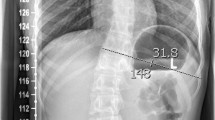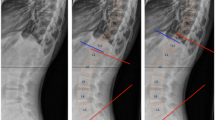Abstract
Introduction
Measurement of the vertebral, local and segmental kyphosis according to Cobb is a standard procedure in the assessment of traumatic, idiopathic and degenerative spinal deformities. The purpose of this study was to evaluate the inter- and intra-observer reliability of these three radiological angles on the basis of lateral X-rays in lumbar spine fractures with spinal kyphosis.
Patients and methods
A consecutive series of 88 patients with traumatic lumbar spine fractures with kyphotic deformities were included in the study. All patients were younger that 50 years of age and had an adequate trauma leading to the fracture. Three independent observers with different levels of clinical training measured the vertebral, segmental and local kyphosis of these patients on the basis of lateral X-rays. The readings were repeated 4 weeks later to assess intra-observer reliability.
Results
The most common injury mechanism was a fall from a height of more than 3 m. The first lumbar vertebra was the most commonly affected. Mean inter- and intra-observer reliabilities were good for the vertebral (mean ICC: 0.6607; mean ICC: 0.6979) and local (mean ICC: 0.7778; mean ICC: 0.7642) kyphosis and excellent (mean ICC: 0.8129; mean ICC: 0.8103) for the segmental kyphosis.
Conclusion
In this study, the segmental-, vertebral-, and local kyphosis angle according to Cobb showed sufficient inter- and intra-observer reliability for the use in daily practice and scientific studies.


Similar content being viewed by others
References
Cybulski GR, Douglas RA, Meyer PR Jr, Rovin RA (1992) Complications in three-column cervical spine injuries requiring anterior–posterior stabilization. Spine 17(3):253–256
Farcy JP, Weidenbaum M, Glassman SD (1990) Sagittal index in management of thoracolumbar burst fractures. Spine 15(9):958–965
Denis F, Armstrong GW, Searls K, Matta L (1984) Acute thoracolumbar burst fractures in the absence of neurologic deficit. A comparison between operative and nonoperative treatment. Clin Orthop Relat Res 189:142–149
Gertzbein SD (1994) Neurologic deterioration in patients with thoracic and lumbar fractures after admission to the hospital. Spine 19(15):1723–1725
Hertlein H, Hartl WH, Dienemann H, Schurmann M, Lob G (1995) Thoracoscopic repair of thoracic spine trauma. Eur Spine J 4(5):302–307
Stotts AK, Smith JT, Santora SD, Roach JW, D’Astous JL (2002) Measurement of spinal kyphosis: implications for the management of Scheuermann’s kyphosis. Spine 27(19):2143–2146
Cobb J (1948) Outline for the study of scoliosis. Am Acad Orthop Surg Instr Course Lect 5:261–275
Böhler J (1971) Conservative treatment of thoracic and lumbar spine fractures. Z Unfallmed Berufskr 2:100–104
Goutallier D, Louis R (1977) Therapeutic indications in unstable fractures of the spine. Rev Chir Orthop Reparatrice Appar Mot 63(5):475–481
Trojan E (1972) Long-term results of 200 vertebral fractures of the thoracic and lumbar spine without paralysis. Z Unfallmed Berufskr 65(2):122–134
McLain RF, Sparling E, Benson DR (1993) Early failure of short-segment pedicle instrumentation for thoraco-lumbar fractures. J Bone Joint Surg Am 75:162–169
Gebhard F, Schultheiss M (2009) Surgical treatment of fractures of the lumbar spine, vol 1. Steinkopff, Darmstatt, pp 129–136
Gstoettner M, Sekyra K, Walochnik N, Winter P, Wachter R, Bach CM (2007) Inter- and intra-observer reliability assessment of the Cobb angle: manual versus digital measurement tools. Eur Spine J 16(10):1587–1592
Sutherland CJ, Miller F, Wang GJ (1983) Early progressive kyphosis following compression fractures. Two case reports from a series of “stable” thoracolumbar compression fractures. Clin Orthop Relat Res 173:216–220
Tayyab NA, Samartzis D, Altiok H, Shuff CE, Lubicky JP, Herman J, Khanna N (2007) The reliability and diagnostic value of radiographic criteria in sagittal spine deformities: comparison of the vertebral wedge ratio to the segmental Cobb angle. Spine 32(16):E451–E459
Tribus CB (1998) Scheuermann’s kyphosis in adolescents and adults: diagnosis and management. J Am Acad Orthop Surg 6(1):36–43
Ulmar B, Richter M, Kelsch G, Cakir B, Puhl W, Huch K (2005) Distractible vertebral body replacement for the thoracic and lumbar spine. Acta Orthop Belg 71(4):467–471
Voutsinas SA, MacEwen GD (1986) Sagittal profiles of the spine. Clin Orthop Relat Res 210:235–242
Briggs AM, Wrigley TV, Tully EA, Adams PE, Greig AM, Bennell KL (2007) Radiographic measures of thoracic kyphosis in osteoporosis: Cobb and vertebral centroid angles. Skeletal Radiol 36(8):761–767
Carman DL, Browne RH, Birch JG (1990) Measurement of scoliosis and kyphosis radiographs. Intraobserver and interobserver variation. J Bone Joint Surg Am 72(3):328–333
Hicks GE, George SZ, Nevitt MA, Cauley JA, Vogt MT (2006) Measurement of lumbar lordosis: inter-rater reliability, minimum detectable change and longitudinal variation. J Spinal Disord Tech 19(7):501–506
Lee SW, Hong JT, Son BC, Sung JH, Kim IS, Park CK (2007) Analysis of accuracy of kyphotic angle measurement for vertebral osteoporotic compression fractures. J Clin Neurosci 14(10):961–965
Magerl F, Aebi M, Gertzbein SD, Harms J, Nazarian S (1994) A comprehensive classification of thoracic and lumbar injuries. Eur Spine J 3(4):184–201
Pfleischifter J (2006) Evidenzbasierte Konsensus Leitlinie zur Osteoporose. Prophylaxe, Diagnostik und Therapie bei Frauen ab der Menopause, bei Männern ab dem 60. Lebensjahr. Schattauer Verlag, Stuttgart, pp 1–343
Landis JR, Koch GG (1977) The measurement of observer agreement for categorical data. Biometrics 33(1):159–174
McAfee PC, Yuan HA, Fredrickson BE, Lubicky JP (1983) The value of computed tomography in thoracolumbar fractures. An analysis of one hundred consecutive cases and a new classification. J Bone Joint Surg Am 65(4):461–473
Harrison DE, Cailliet R, Harrison DD, Janik TJ, Holland B (2001) Reliability of centroid, Cobb, and Harrison posterior tangent methods: which to choose for analysis of thoracic kyphosis. Spine 26(11):E227–E234
Morrissy RT, Goldsmith GS, Hall EC, Kehl D, Cowie GH (1990) Measurement of the Cobb angle on radiographs of patients who have scoliosis. Evaluation of intrinsic error. J Bone Joint Surg Am 72(3):320–327
Polly DW Jr, Kilkelly FX, McHale KA, Asplund LM, Mulligan M, Chang AS (1996) Measurement of lumbar lordosis. Evaluation of intraobserver, interobserver, and technique variability. Spine 21(13):1530–1535 discussion 5–6
Kuklo TR, Polly DW, Owens BD, Zeidman SM, Chang AS, Klemme WR (2001) Measurement of thoracic and lumbar fracture kyphosis: evaluation of intraobserver, interobserver, and technique variability. Spine 26(1):61–65 discussion 6
Seel EH, Verrill CL, Mehta RL, Davies EM (2005) Measurement of fracture kyphosis with the Oxford Cobbometer: intra- and interobserver reliabilities and comparison with other techniques. Spine 30(8):964–968
Author information
Authors and Affiliations
Corresponding author
Rights and permissions
About this article
Cite this article
Ulmar, B., Gühring, M., Schmälzle, T. et al. Inter- and intra-observer reliability of the Cobb angle in the measurement of vertebral, local and segmental kyphosis of traumatic lumbar spine fractures in the lateral X-ray. Arch Orthop Trauma Surg 130, 1533–1538 (2010). https://doi.org/10.1007/s00402-010-1104-5
Received:
Published:
Issue Date:
DOI: https://doi.org/10.1007/s00402-010-1104-5




